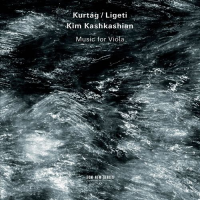Home » Jazz Articles » Album Review » Kim Kashkashian: Kurtag/Ligeti: Music for Viola
Kim Kashkashian: Kurtag/Ligeti: Music for Viola
Boston-based Kim Kashkashian is one of the premier violists in the world and has recorded many fine, edgy and stimulating albums. With Kurtág/Ligeti: Music for Viola, she tackles two of the more challenging composers of the last half of the 20th century: Hungarians György Ligeti and György Kurtág. The two men not only share a first name and a national heritage but also a common inspirational source, as both are intellectual disciples of their great countryman, Béla Bartók.
Kashkashian has dedicated a significant portion of her career in studying Kurtág's uniquely intricate body of work. This is her third Kurtág recording. The nineteen-part "Signs, Games and Messages," started in 1989, runs only half an hour and is considered a work in progress by its creator. Supreme adroitness, with which she is endowed, is not enough, to interpret successfully this evanescent and cryptic composition. This is where Kashkashian's deep sympathy and understanding of the Kurtag's oeuvre comes in. Her sublime approach to the demanding and unconventional harmonic and rhythmic changes make the score a living, evolving being.
She goes from deferentially and softly touching the strings on "Silent Lines to László Dobszay" to the almost dancing notes of the folk-inspired "Perpetuum Mobile." Her lilting sound beautifully illustrates the nostalgic mood on "For Imre Földes At 60." She also delivers, with subtle whimsy, the theatrical "Signs 1" and "Signs 2."
The more conventional, six-movement "Sonata for Solo Viola" shares its ethnic influence and idiosyncratic construct with "Signs, Games and Messages," but differs it in its solid character and musical heft. While Kurtág's work is ethereal, Ligeti's is earthbound.
Kashkashian's bowing is like a human voice, melancholically singing a folkloric melody on "Hora Lunga." She introduces the right amount of dissonance in the spirited "Loop," while coaxing a whole quartet worth of sound out of single instrument on "Fascar." She navigates the fast tempo of a modern tale of anxiety deftly and with grace on "Prestissimo Con Sordino," and expresses a gamut of emotions on the mournful, angry yet quietly reconciliatory "Lamento." She closes the album with muted tones and shimmering colors of the suite's sixth and last movement, "Chaconne chromatique."
An educator at the New England Conservatory of Music and a tireless advocate of the much-maligned viola, Kashkashian has delivered, once more, a resplendent record that not only explores the instrument's range and versatility but also introduces two ambitious yet surprisingly accessible gems.
Track Listing
In Nomine - all'ongherese (Damjanich emlékko); Silent Lines To László Dobszay Letter to Vera Ligeti; For Imre Földes At 60; Chromatically Saucy; A Flower For Dénes Zsigmondy; In memoriam Blum Tamás; In memoriam Aczél György; H.J. - nóta; Vagdalkozós; The Carenza Jig; Kroó György in memoriam; Hommage à John Cage; Doloroso; Perpetuum mobile; Signs I; Signs II;Four Entwined Bodies To The Exhibition By Sári Gerlóczy; Panaszos nóta; Hora lung; Loop; Facsar; Prestissimo con sordino; Lamento; Chaconne chromatique.
Personnel
Kim Kashkashian
violaKim Kashkashian: viola.
Album information
Title: Kurtag/Ligeti: Music for Viola | Year Released: 2012 | Record Label: ECM Records
< Previous
Cork Jazz Festival: Cork, Ireland, Oc...
Next >
Working Nights
Comments
Tags
For the Love of Jazz
 All About Jazz has been a pillar of jazz since 1995, championing it as an art form and, more importantly, supporting the musicians who create it. Our enduring commitment has made "AAJ" one of the most culturally important websites of its kind, read by hundreds of thousands of fans, musicians and industry figures every month.
All About Jazz has been a pillar of jazz since 1995, championing it as an art form and, more importantly, supporting the musicians who create it. Our enduring commitment has made "AAJ" one of the most culturally important websites of its kind, read by hundreds of thousands of fans, musicians and industry figures every month.





















